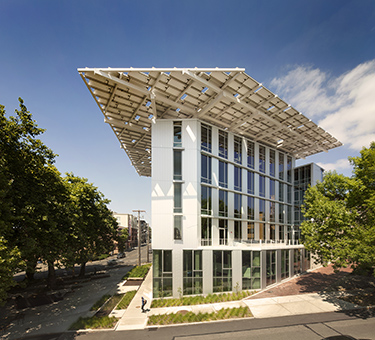|
Subscribe / Renew |
|
|
Contact Us |
|
| ► Subscribe to our Free Weekly Newsletter | |
| home | Welcome, sign in or click here to subscribe. | login |
Architecture & Engineering
| |
 |
October 31, 2013
A&E 2013 Surveys: PAE Consulting Engineers
Specialty: Mechanical and electrical engineering
Management: Steve Reidy, Seattle office managing principal
Founded: 1969
Headquarters: Portland
Projects: Downtown Renton and Mercer Island libraries for King County Library System; Seattle Prep; Lakeside School; Pacific Lutheran University Eastvold Hall; Bellarmine Prep; Federal Way Performing Arts Center
PAE Consulting Engineers has worked on just about every kind of building there is — from universities, schools and healthcare facilities to offices and apartments. Steve Reidy, managing principal at PAE, has insight on trends for all different types of buildings:
Q: What are your thoughts on Seattle’s apartment boom?
A: I really can’t see an end to the boom for this sector, the traffic congestion and urban campuses like Amazon fuel the apartment boom. Also, the increasing mobilization of the urban workforce is fueling the trend. I think the city has a long way before the apartment and condo markets are overbuilt.
I would look for this cycle to last at least another five to 10 years. The large waterfront project will draw more attention to the downtown core in the future when the project is complete.
Q: You’ve been a part of Amazon’s growth in South Lake Union. What is the secret to their success?
A: Amazon has brought forward the movement of building development for creative services clients. In this market, the priorities of the building elements and systems are different from the antiquated commercial real-estate ranking system (Class A, B, C).
Amazon has helped push the older mind-set away and brought the newer creative client needs to the forefront of the industry. Companies like Google, Apple, Facebook are also in the development cycle of this revolution.
Q: What sustainable elements have you introduced into your projects?
A: We have developed and implemented ground source heat exchangers (open and closed loop systems), natural ventilation, on-site wastewater treatment (living machine, composting, membrane bio-reactor), radiant systems (chilled beams, ceiling radiant panels, radiant floors) for both heating and cooling, daylighting, photovoltaic arrays, wind generators, phase change materials, displacement ventilation, fuel cells.
The largest sustainable elements are the projects where the collaborative process allows the design team to shape the buildings to optimize energy efficiency.
Q: What trends are you seeing in school and university design?
A: Schools and universities have designed their facilities for more campus interconnections in the utilities. The first ecodistricts will be in the university campus levels. Current trends are pushing the energy consumption of these buildings down in an aggressive rate. Net-zero buildings are a reality now, just working to keep the costs down.
Q: You do a lot of work in Oregon as well as Seattle, how does Portland compare to Seattle?
A: Portland and Seattle are different. The mix of public versus private is very different, Seattle has much more private sector work. Portland has a much more developed condo market, Seattle has more high-rise residential mixed use. Housing in Seattle has gone in the “micro” apartments where Portland has not seen that trend yet. I can see Seattle’s condo market taking off as long as the housing recovery continues at an even pace.
Trends in office design are following very parallel paths, where the creative space projects are getting higher occupancy and many older 20- to 30-year-old buildings that do not have those creative attributes are being left behind. It’s very sad to see those buildings continue to fall behind.
Q: How has the company changed since the recession?
A: Our company has held very strong through the recession. Our growth has surpassed the pre-recession point by 50 percent already. We have been very lucky in winning the talent war for the staff that fuels our business.
Other Stories:
- ‘Standard of care’ is all about reasonable expectations
- A&E 2013 Surveys: BergerABAM
- A&E 2013 Surveys: Runberg Architecture Group
- A&E 2013 Surveys: Freiheit & Ho Architects
- A&E 2013 Surveys: Fossatti Pawlak Structural Engineers
- A&E 2013 Surveys: Hewitt
- A&E 2013 Surveys: GGLO
- Architecture: It’s not science, it’s art
- Designing a waterfront entrance for Pike Place Market
- Now hear this: ADA updates listening device rules
- Tech influence ripples across the design world
- Can’t find a lender? Try crowdfunding
- A&E 2013 Surveys: Weber Thompson



